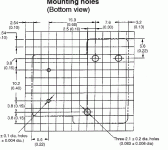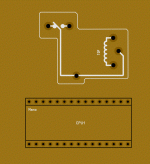What I am proposing is a cell phone like power supply walled plugged 12 V 1 or 2 amp plugged into a AREA of a amp pcb that will run and control the amp...
A phone charger is pretty light on current for the relays needed. There is a 12 0 12 relay on board here dedicated to this board only.
Last edited:
A phone charger is pretty light on current for the relays needed. There is a 12 0 12 relay on board here dedicated to this board only.
This relay only uses 77mils, could it be used?
G8P-1C4P DC12 Omron Electronics Inc-EMC Div | Z1009-ND | DigiKey
Or we could use some MosFet output relays... like www.esperado.fr - Protection d'amplificateur ultime
Maybe better in that it is all solid state...
Maybe better in that it is all solid state...
I prefer chassis mount relays personally. I'm on a phone so it's tough to pull up a data sheet but I don't think those are rated for 120/240 vac.
Switching Voltage 250VAC, 28VDC - Max
How large are they? If they are the small automotive version they might be good to keep everything self contained.
Attachments
my control board has its own 9-0-9V transformer for 12V to drive fan and also a 5V reg for driving relays.
----------
btw, on the subject of active cooling: for all practical purposes the quiet Noctua fan is impossible (!) to pick out noisewise. I have to lean over the amp and look hard through a 9nch long heatsink to see if it is spinning. (you could see here other members (lhquam) say the same about the fan). btw I profesionally deal with unwanted noises in cars, often very subtle noises right off the noise floor in measured data, so you can take my expert word for it (I won't bother taking measurements, just check out the press they received).
-----------
yes we used PICbasic and some assembler too where it was necessary.
a suggestion: to make a full use of a platform like Arduino, and if you guys want to attract others you want to put a lot of thought into making an architecture which can be reconfigured with jumper settings for as many different functions as possible and do it as a COLLABORATIVE GROUP PROJECT! (i.e. invite others with skills and time to spare).
you may also want to add sought-after, mainstream functions like multichannel volume control, with variable gain settings, etc. etc. see Mikkel's boards at www.dantimax(dot)dk . a nice display with multi-level user interface with turn/push buttons is also a must (see AlephP example at DIY Audio Projects ).you also may have to put A LOT of effort into documenting everything for others and be ready to make the source code available for custom modifications if necessary, (for example to drive a different model fan).
I never fed all the changes we made on prototype boards back into schematics etc. (a lot of handwritten notes on the original sch), and I am so busy with other projects I cannot post anything right away. but I can later on if you will benefit from those.
----------
btw, on the subject of active cooling: for all practical purposes the quiet Noctua fan is impossible (!) to pick out noisewise. I have to lean over the amp and look hard through a 9nch long heatsink to see if it is spinning. (you could see here other members (lhquam) say the same about the fan). btw I profesionally deal with unwanted noises in cars, often very subtle noises right off the noise floor in measured data, so you can take my expert word for it (I won't bother taking measurements, just check out the press they received).
-----------
yes we used PICbasic and some assembler too where it was necessary.
a suggestion: to make a full use of a platform like Arduino, and if you guys want to attract others you want to put a lot of thought into making an architecture which can be reconfigured with jumper settings for as many different functions as possible and do it as a COLLABORATIVE GROUP PROJECT! (i.e. invite others with skills and time to spare).
you may also want to add sought-after, mainstream functions like multichannel volume control, with variable gain settings, etc. etc. see Mikkel's boards at www.dantimax(dot)dk . a nice display with multi-level user interface with turn/push buttons is also a must (see AlephP example at DIY Audio Projects ).you also may have to put A LOT of effort into documenting everything for others and be ready to make the source code available for custom modifications if necessary, (for example to drive a different model fan).
I never fed all the changes we made on prototype boards back into schematics etc. (a lot of handwritten notes on the original sch), and I am so busy with other projects I cannot post anything right away. but I can later on if you will benefit from those.
Last edited:
Or we could use some MosFet output relays... like www.esperado.fr - Protection d'amplificateur ultime
Maybe better in that it is all solid state...
Definitely use solid state relays! No need to buy, just use a photovoltaic isolator (APV1121 works well and is cheap) and and pair of MOSFETs with suitable voltage and current rating with the lowest RdsOn you can afford.
It wouldn't be a 21st Century protection board if you used mechanical relays
You work with the design and PIC software looks great, well done
A (patented) technique for this is to, before connecting the transformer to the mains, to bring the transformer close to saturation with a DC signal, and then activate the mains when the voltage is at its peak (top or bottom depending on the magnetic charge by the DC prime). This starts up the x-former as if it was already connected to the mains without any turn-on current peak.Solid state could possibly do away with softstart resistors as well. Ramp the fets up with PWM feeding the transformer.
However, this doesn't deal with the initial charge of the reservoir caps. To this end, SCRs could be used instead of a normal rectifier to control the charge-up of the reservoir elcos. Both methods are pretty hi-tech and if you want to do this right, you'd have to employ both.
I've been researching this as I'm dealing with a 1.7KVA toroid and 80mF reservoir capacitance. I decided to settle for the classic softstart resistor
I thought of that too, but depending on when a previous shutdown has occured, the magnetic flux can be polarized 'wrongly' in relation to the triac startup pulse, generating a peak charge current magnitudes higher than a regular startup peak; the transformer momentarily looks like a short to the mains. It's been a while ago, another Dutch guy has been doing all kinds of measurements on transformer startup. I'll see if I can find the topic, but it has to be taken through a translator. a ZCD is needed anyhow no matter which method you'd choose. I designed one that consumed only a couple of mW and still delivered a good, solid digital pulse.Why not use a zero cross detection system and PULSE up a triac, over a short duration to the mains on a OPS transformer power supply?
Last edited:
A (patented) technique for this is to, before connecting the transformer to the mains, to bring the transformer close to saturation with a DC signal, and then activate the mains when the voltage is at its peak (top or bottom depending on the magnetic charge by the DC prime). This starts up the x-former as if it was already connected to the mains without any turn-on current peak.
However, this doesn't deal with the initial charge of the reservoir caps. To this end, SCRs could be used instead of a normal rectifier to control the charge-up of the reservoir elcos. Both methods are pretty hi-tech and if you want to do this right, you'd have to employ both.
I've been researching this as I'm dealing with a 1.7KVA toroid and 80mF reservoir capacitance. I decided to settle for the classic softstart resistor
Clock work on a piece of cake with ice cream... easy
- Status
- This old topic is closed. If you want to reopen this topic, contact a moderator using the "Report Post" button.
- Home
- Amplifiers
- Solid State
- How to build a 21st century protection board

